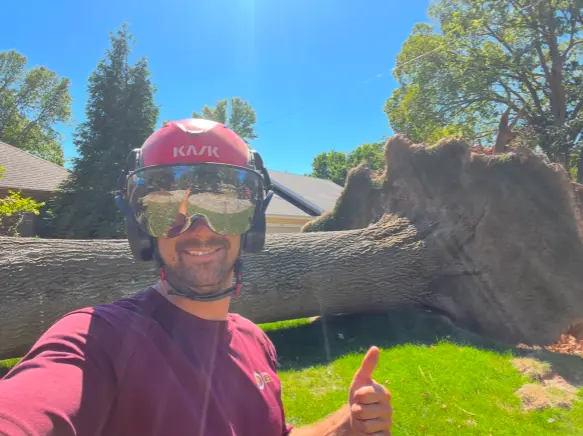Emergency Tree Care
Emergency Tree Care When You Need It Most
Have you woken up to find a massive tree branch sprawled across your driveway, blocking you in, or a tree leaning precariously toward your roof? Whether it’s the result of a powerful storm, heavy winds, or years of internal decay, a fallen or dangerously damaged tree can pose a serious risk to your home, your family, and your safety. Thankfully, All About Trees offers emergency tree services in Springfield, MO, and the surrounding areas.
Our ISA-certified arborists can assess the situation and restore your peace of mind with fast and effective care. No matter if you have broken limbs or entire trees resting or leaning on other trees, structures, or cars, we can provide a timely solution and minimize the amount of damage done. Call today for help with your tree emergency!

Why We’re the Right Arborist for the Job
Membership in Professional Organizations
All About Trees is proud to be a member of several highly respected tree care associations, including the Tree Care Industry Association (TCIA) and the International Society of Arboriculture (ISA). These affiliations keep us informed of the latest safety protocols, industry standards, and best practices in tree care and removal. We’re also a proud member of the Springfield Area Chamber of Commerce because we’re committed to our community.
ISA-Certified Arborists
Our team includes ISA-certified arborists, which means you’ll have knowledgeable, skilled professionals managing your tree emergency. We have extensive knowledge of tree biology, risk assessment, and safe work practices, so you can feel confident that your trees are in expert hands.
Fully Insured for Your Protection
Tree removal can be dangerous work. That’s why we carry full liability insurance and workers’ compensation coverage. Should anything unexpected happen during your emergency tree care service, you won’t be held financially responsible.
We Follow Industry-Accepted Practices
We don’t take shortcuts. Instead, our arborists follow ANSI A300 protocols, the gold standard in the industry. We will make sure each tree is removed or treated with precision and safety. We will also never top a tree, remove an excessive amount of live wood, use climbing spikes on trees that are not being removed, or cut down living trees without just cause.
Free Estimates and Transparent Communication
Even in an emergency, you deserve clear communication. That’s why we provide free, no-obligation estimates for emergency tree removal in Springfield, MO. We’ll assess the situation and provide a detailed plan of action, including the cost and timeline, so you’re never left guessing.
Ongoing Support After the Emergency
Once the immediate danger is resolved, our work isn’t necessarily done. We offer continued support to help you assess the health of your remaining trees, perform necessary pruning, and even recommend plant health care solutions to enable trees to recover from storms and strong winds. Whatever your tree needs, we can provide it.
Why We’re the Right Arborist for the Job
Membership in Professional Organizations
All About Trees is proud to be a member of several highly respected tree care associations, including the Tree Care Industry Association (TCIA) and the International Society of Arboriculture (ISA). These affiliations keep us informed of the latest safety protocols, industry standards, and best practices in tree care and removal. We’re also a proud member of the Springfield Area Chamber of Commerce because we’re committed to our community.
ISA-Certified Arborists
Our team includes ISA-certified arborists, which means you’ll have knowledgeable, skilled professionals managing your tree emergency. We have extensive knowledge of tree biology, risk assessment, and safe work practices, so you can feel confident that your trees are in expert hands.
Fully Insured for Your Protection
Tree removal can be dangerous work. That’s why we carry full liability insurance and workers’ compensation coverage. Should anything unexpected happen during your emergency tree care service, you won’t be held financially responsible.
We Follow Industry-Accepted Practices
We don’t take shortcuts. Instead, our arborists follow ANSI A300 protocols, the gold standard in the industry. We will make sure each tree is removed or treated with precision and safety. We will also never top a tree, remove an excessive amount of live wood, use climbing spikes on trees that are not being removed, or cut down living trees without just cause.
Free Estimates and Transparent Communication
Even in an emergency, you deserve clear communication. That’s why we provide free, no-obligation estimates for emergency tree removal in Springfield, MO. We’ll assess the situation and provide a detailed plan of action, including the cost and timeline, so you’re never left guessing.
Ongoing Support After the Emergency
Once the immediate danger is resolved, our work isn’t necessarily done. We offer continued support to help you assess the health of your remaining trees, perform necessary pruning, and even recommend plant health care solutions to enable trees to recover from storms and strong winds. Whatever your tree needs, we can provide it.

Do You Have a Tree Emergency?
Are you wondering if it’s time to call for emergency tree services? We know it can be challenging to know when an issue requires immediate attention from a certified arborist and when it can wait for the next available appointment. If you’re unsure whether the situation is urgent, give All About Trees a call — we’re happy to offer guidance.
In many cases, the following scenarios require emergency tree care:
- A tree is blocking a road or driveway.
- A tree has fallen on a home, garage, building, or fence.
- There are broken branches dangling into high-traffic areas.
- A tree has been struck by lightning.
- The tree is uprooted or leaning.

Be an Informed Consumer
Our Safety Standards
We are licensed and insured for your protection, and we can prove it! To obtain a free copy of our proof of insurance, just give us a call. We carry insurance for:
- Liability
- Auto
- Property
- Workers’ Compensation
The Importance of Caring for Damaged or Fallen Trees ASAP
It might seem harmless to leave a cracked branch or leaning tree untouched, especially if it hasn’t fallen yet, but it’s important to realize that these situations can change in an instant. A partially broken limb may seem secure until it drops on a car or person without warning. Similarly, a tree leaning just a few degrees today could be flat on the ground by tomorrow — taking fences, roofs, or entire structures with it.
There’s also the added stress of complications that arise the longer you wait. Water can seep in through roof damage, pests can infiltrate wounded branches, and mounting debris becomes more complicated and expensive to clean up the longer it’s postponed. And from a legal perspective, ignoring a known hazard can leave you liable for damages or injuries if the tree eventually causes harm. For these reasons, addressing tree issues immediately is always the safer — and smarter — choice.
